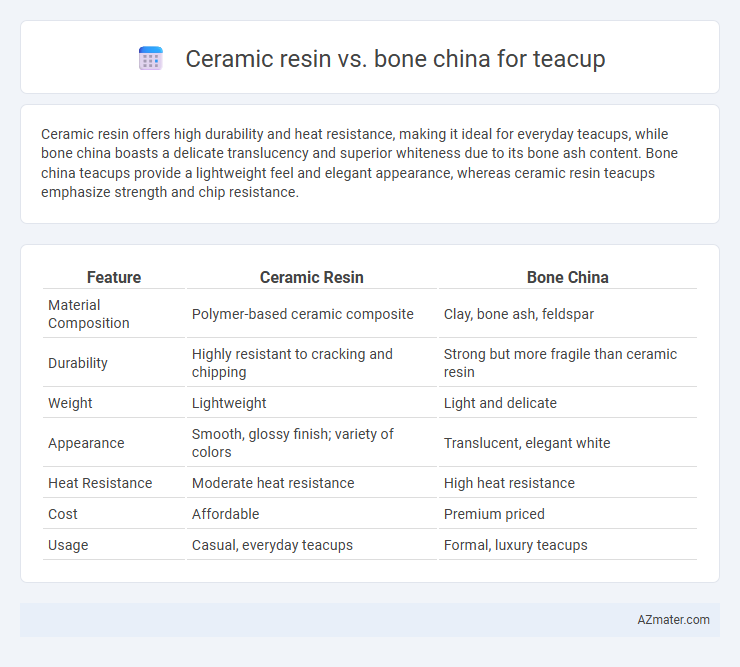Ceramic resin offers high durability and heat resistance, making it ideal for everyday teacups, while bone china boasts a delicate translucency and superior whiteness due to its bone ash content. Bone china teacups provide a lightweight feel and elegant appearance, whereas ceramic resin teacups emphasize strength and chip resistance.
Table of Comparison
| Feature | Ceramic Resin | Bone China |
|---|---|---|
| Material Composition | Polymer-based ceramic composite | Clay, bone ash, feldspar |
| Durability | Highly resistant to cracking and chipping | Strong but more fragile than ceramic resin |
| Weight | Lightweight | Light and delicate |
| Appearance | Smooth, glossy finish; variety of colors | Translucent, elegant white |
| Heat Resistance | Moderate heat resistance | High heat resistance |
| Cost | Affordable | Premium priced |
| Usage | Casual, everyday teacups | Formal, luxury teacups |
Introduction: Ceramic Resin vs Bone China Teacups
Ceramic resin teacups offer enhanced durability and resistance to chipping, making them ideal for everyday use, while bone china teacups are prized for their thin, lightweight structure and exquisite translucency, reflecting their high calcium phosphate content. Bone china typically contains 25-50% bone ash, providing a unique strength-to-weight ratio and a delicate, refined appearance favored in luxury tableware. Ceramic resin blends traditional clay materials with synthetic resins, resulting in teacups that maintain aesthetic appeal but boast greater toughness and heat retention compared to classic bone china.
Material Composition: Comparing Ceramic Resin and Bone China
Ceramic resin teacups are crafted from a blend of ceramic particles and synthetic resins, offering increased durability and chip resistance compared to traditional ceramics. Bone china, composed of bone ash, feldspathic material, and kaolin, is renowned for its lightweight, translucency, and high mechanical strength. The unique material composition of bone china results in a more delicate yet resilient teacup, while ceramic resin provides a more robust and less fragile alternative suited for everyday use.
Manufacturing Process Differences
Ceramic resin teacups are crafted by mixing ceramic powders with synthetic resins, then molded and cured under heat to achieve durability and a smooth finish. Bone china teacups are produced by combining bone ash, kaolin, and feldspar, then fired at high temperatures to create a translucent, lightweight, and strong material. The key manufacturing difference lies in resin binding versus bone ash composition combined with firing methods, influencing strength, translucency, and texture.
Durability and Strength Comparison
Ceramic resin teacups exhibit superior durability due to their resistance to chipping and cracking compared to bone china, which, while elegant, tends to be more fragile and prone to damage upon impact. The strength of ceramic resin allows for daily use and withstands thermal shock better, making it ideal for busy households or commercial settings. Bone china, composed of bone ash, feldspathic material, and kaolin, offers a delicate translucence but requires careful handling to maintain its structural integrity.
Aesthetic Appeal and Design Versatility
Ceramic resin teacups offer a wide range of aesthetic appeal with their ability to mimic various textures and finishes, providing versatile design options from matte to glossy surfaces. Bone china teacups are prized for their translucent, delicate appearance and elegant whiteness, which exudes sophistication and classic beauty. Design versatility in bone china is often enhanced by intricate hand-painted patterns and fine detailing, making it a preferred choice for traditional and luxury teaware.
Heat Retention and Tea Drinking Experience
Ceramic resin teacups offer superior heat retention due to their dense, non-porous structure, keeping tea warmer for longer periods compared to bone china. Bone china, while elegant and lightweight, tends to cool tea faster thanks to its thinner walls and higher porosity. For tea enthusiasts prioritizing a prolonged and consistent warm tea drinking experience, ceramic resin is a preferred material.
Weight and Handling Comfort
Ceramic resin teacups are generally lighter than bone china, making them easier to handle and less tiring during prolonged use. Bone china, known for its fine, translucent quality, often has a slightly heavier feel which contributes to a more substantial grip and perceived luxury. The balance between weight and comfort depends on personal preference, with ceramic resin favoring ease of handling and bone china offering a premium tactile experience.
Safety and Toxicity Concerns
Ceramic resin teacups often contain synthetic polymers that may leach harmful chemicals like BPA when exposed to high temperatures, raising safety and toxicity concerns. Bone china, made from natural materials including bone ash, kaolin, and feldspar, is known for its non-toxic composition and durability, making it a safer choice for daily use. Testing for lead and cadmium is crucial in both materials, but bone china typically undergoes strict quality controls ensuring minimal toxic element exposure.
Price Point and Market Value
Ceramic resin teacups generally offer a more affordable price point due to lower production costs and greater material availability, making them popular for everyday use. Bone china teacups command a higher market value as they combine fine bone ash with porcelain, resulting in superior translucency, durability, and a premium aesthetic. The prestige and craftsmanship associated with bone china increase its appeal among collectors and luxury buyers, sustaining higher retail prices compared to ceramic resin alternatives.
Choosing the Right Teacup: Ceramic Resin or Bone China?
Ceramic resin teacups offer durability and resistance to chipping, making them ideal for everyday use, while bone china teacups are prized for their delicate translucency and refined elegance, perfect for formal settings. Bone china's composition of bone ash, feldspar, and kaolin results in a lightweight and strong cup with superior heat retention, whereas ceramic resin typically involves a composite material that mimics ceramic texture but with enhanced toughness. Choosing between ceramic resin and bone china hinges on balancing practicality versus aesthetic appeal and deciding whether durability or a traditional, luxurious experience is the priority for your tea enjoyment.

Infographic: Ceramic resin vs Bone china for Teacup
 azmater.com
azmater.com